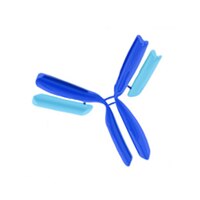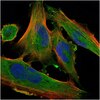Identification of two novel synaptic γ-secretase associated proteins that affect amyloid β-peptide levels without altering Notch processing.
Susanne Frykman,Yasuhiro Teranishi,Ji-Yeun Hur,Anna Sandebring,Natsuko Goto Yamamoto,Maria Ancarcrona,Takeshi Nishimura,Bengt Winblad,Nenad Bogdanovic,Sophia Schedin-Weiss,Takahiro Kihara,Lars O Tjernberg
Neurochemistry international
61
2011
Afficher le résumé
Synaptic degeneration is one of the earliest hallmarks of Alzheimer disease (AD) and results in loss of cognitive function. One of the causative agents for the synaptic degeneration is the amyloid β-peptide (Aβ), which is formed from its precursor protein by two sequential cleavages mediated by β- and γ-secretase. We have earlier shown that γ-secretase activity is enriched in synaptic compartments, suggesting that the synaptotoxic Aβ is produced locally. Proteins that interact with γ-secretase at the synapse and regulate the production of Aβ can therefore be potential therapeutic targets. We used a recently developed affinity purification approach to identify γ-secretase associated proteins (GSAPs) in synaptic membranes and synaptic vesicles prepared from rat brain. Liquid chromatography-tandem mass spectrometry analysis of the affinity purified samples revealed the known γ-secretase components presenilin-1, nicastrin and Aph-1b along with a number of novel potential GSAPs. To investigate the effect of these GSAPs on APP processing, we performed siRNA experiments to knock down the expression of the GSAPs and measured the Aβ levels. Silencing of NADH dehydrogenase [ubiquinone] iron-sulfur protein 7 (NDUFS7) resulted in a decrease in Aβ levels whereas silencing of tubulin polymerization promoting protein (TPPP) resulted in an increase in Aβ levels. Treatment with γ-secretase inhibitors often results in Notch-related side effects and therefore we also studied the effect of the siRNAs on Notch processing. Interestingly, silencing of TPPP or NDUFS7 did not affect cleavage of Notch. We also studied the expression of TPPP and NDUFS7 in control and AD brain and found NDUFS7 to be highly expressed in vulnerable neurons such as pyramidal neurons in the hippocampus, whereas TPPP was found to accumulate in intraneuronal granules and fibrous structures in hippocampus from AD cases. In summary, we here report on two proteins, TPPP and NDUFS7, which interact with γ-secretase and alter the Aβ levels without affecting Notch cleavage. | 22521230
 |
Identification of novel γ-secretase-associated proteins in detergent-resistant membranes from brain.
Hur, JY; Teranishi, Y; Kihara, T; Yamamoto, NG; Inoue, M; Hosia, W; Hashimoto, M; Winblad, B; Frykman, S; Tjernberg, LO
The Journal of biological chemistry
287
11991-2005
2011
Afficher le résumé
In Alzheimer disease, oligomeric amyloid β-peptide (Aβ) species lead to synapse loss and neuronal death. γ-Secretase, the transmembrane protease complex that mediates the final catalytic step that liberates Aβ from its precursor protein (APP), has a multitude of substrates, and therapeutics aimed at reducing Aβ production should ideally be specific for APP cleavage. It has been shown that APP can be processed in lipid rafts, and γ-secretase-associated proteins can affect Aβ production. Here, we use a biotinylated inhibitor for affinity purification of γ-secretase and associated proteins and mass spectrometry for identification of the purified proteins, and we identify novel γ-secretase-associated proteins in detergent-resistant membranes from brain. Furthermore, we show by small interfering RNA-mediated knockdown of gene expression that a subset of the γ-secretase-associated proteins, in particular voltage-dependent anion channel 1 (VDAC1) and contactin-associated protein 1 (CNTNAP1), reduced Aβ production (Aβ40 and Aβ42) by around 70%, whereas knockdown of presenilin 1, one of the essential γ-secretase complex components, reduced Aβ production by 50%. Importantly, these proteins had a less pronounced effect on Notch processing. We conclude that VDAC1 and CNTNAP1 associate with γ-secretase in detergent-resistant membranes and affect APP processing and suggest that molecules that interfere with this interaction could be of therapeutic use for Alzheimer disease. | 22315232
 |
gamma-Secretase dependent production of intracellular domains is reduced in adult compared to embryonic rat brain membranes.
Frånberg, J; Karlström, H; Winblad, B; Tjernberg, LO; Frykman, S
PloS one
5
e9772
2009
Afficher le résumé
gamma-Secretase is an intramembrane aspartyl protease whose cleavage of the amyloid precursor protein (APP) generates the amyloid beta-peptide (Abeta) and the APP intracellular domain. Abeta is widely believed to have a causative role in Alzheimer's disease pathogenesis, and therefore modulation of gamma-secretase activity has become a therapeutic goal. Besides APP, more than 50 substrates of gamma-secretase with different cellular functions during embryogenesis as well as adulthood have been revealed. Prior to gamma-secretase cleavage, substrates are ectodomain shedded, producing membrane bound C-terminal fragments (CTFs).Here, we investigated gamma-secretase cleavage of five substrates; APP, Notch1, N-cadherin, ephrinB and p75 neurotrophin receptor (p75-NTR) in membranes isolated from embryonic, young or old adult rat brain by analyzing the release of the corresponding intracellular domains (ICDs) or Abeta40 by western blot analysis and ELISA respectively. The highest levels of all ICDs and Abeta were produced by embryonic membranes. In adult rat brain only cleavage of APP and Notch1 could be detected and the Abeta40 and ICD production from these substrates was similar in young and old adult rat brain. The CTF levels of Notch1, N-cadherin, ephrinB and p75-NTR were also clearly decreased in the adult brain compared to embryonic brain, whereas the APP CTF levels were only slightly decreased.In summary our data suggests that gamma-secretase dependent ICD production is down-regulated in the adult brain compared to embryonic brain. In addition, the present approach may be useful for evaluating the specificity of gamma-secretase inhibitors. | 20333303
 |
Synaptic and endosomal localization of active gamma-secretase in rat brain.
Frykman, S; Hur, JY; Frånberg, J; Aoki, M; Winblad, B; Nahalkova, J; Behbahani, H; Tjernberg, LO
PloS one
5
e8948
2009
Afficher le résumé
A key player in the development of Alzheimer's disease (AD) is the gamma-secretase complex consisting of at least four components: presenilin, nicastrin, Aph-1 and Pen-2. gamma-Secretase is crucial for the generation of the neurotoxic amyloid beta-peptide (Abeta) but also takes part in the processing of many other substrates. In cell lines, active gamma-secretase has been found to localize primarily to the Golgi apparatus, endosomes and plasma membranes. However, no thorough studies have been performed to show the subcellular localization of the active gamma-secretase in the affected organ of AD, namely the brain.We show by subcellular fractionation of rat brain that high gamma-secretase activity, as assessed by production of Abeta40, is present in an endosome- and plasma membrane-enriched fraction of an iodixanol gradient. We also prepared crude synaptic vesicles as well as synaptic membranes and both fractions showed high Abeta40 production and contained high amounts of the gamma-secretase components. Further purification of the synaptic vesicles verified the presence of the gamma-secretase components in these compartments. The localization of an active gamma-secretase in synapses and endosomes was confirmed in rat brain sections and neuronal cultures by using a biotinylated gamma-secretase inhibitor together with confocal microscopy.The information about the subcellular localization of gamma-secretase in brain is important for the understanding of the molecular mechanisms of AD. Furthermore, the identified fractions can be used as sources for highly active gamma-secretase. | 20126630
 |
Protein-sphingolipid interactions within cellular membranes.
Haberkant, P; Schmitt, O; Contreras, FX; Thiele, C; Hanada, K; Sprong, H; Reinhard, C; Wieland, FT; Brügger, B
Journal of lipid research
49
251-62
2008
Afficher le résumé
Each intracellular organelle critically depends on maintaining its specific lipid composition that in turn contributes to the biophysical properties of the membrane. With our knowledge increasing about the organization of membranes with defined microdomains of different lipid compositions, questions arise regarding the molecular mechanisms that underlie the targeting to/segregation from microdomains of a given protein. In addition to specific lipid-transmembrane segment interactions as a basis for partitioning, the presence in a given microdomain may alter the conformation of proteins and, thus, the activity and availability for regulatory modifications. However, for most proteins, the specific lipid environment of transmembrane segments as well as its relevance to protein function and overall membrane organization are largely unknown. To help fill this gap, we have synthesized a novel photoactive sphingolipid precursor that, together with a precursor for phosphoglycerolipids and with photo-cholesterol, was investigated in vivo with regard to specific protein transmembrane span-lipid interactions. As a proof of principle, we show specific labeling of the ceramide transporter with the sphingolipid probe and describe specific in vivo interactions of lipids with caveolin-1, phosphatidylinositol transfer protein beta, and the mature form of nicastrin. This novel photolabile sphingolipid probe allows the detection of protein-sphingolipid interactions within the membrane bilayer of living cells. | 17906222
 |
Presenilin 1 mediates the turnover of telencephalin in hippocampal neurons via an autophagic degradative pathway.
Esselens, Cary, et al.
J. Cell Biol., 166: 1041-54 (2004)
2004
Afficher le résumé
Presenilin 1 (PS1) interacts with telencephalin (TLN) and the amyloid precursor protein via their transmembrane domain (Annaert, W.G., C. Esselens, V. Baert, C. Boeve, G. Snellings, P. Cupers, K. Craessaerts, and B. De Strooper. 2001. Neuron. 32:579-589). Here, we demonstrate that TLN is not a substrate for gamma-secretase cleavage, but displays a prolonged half-life in PS1(-/-) hippocampal neurons. TLN accumulates in intracellular structures bearing characteristics of autophagic vacuoles including the presence of Apg12p and LC3. Importantly, the TLN accumulations are suppressed by adenoviral expression of wild-type, FAD-linked and D257A mutant PS1, indicating that this phenotype is independent from gamma-secretase activity. Cathepsin D deficiency also results in the localization of TLN to autophagic vacuoles. TLN mediates the uptake of microbeads concomitant with actin and PIP2 recruitment, indicating a phagocytic origin of TLN accumulations. Absence of endosomal/lysosomal proteins suggests that the TLN-positive vacuoles fail to fuse with endosomes/lysosomes, preventing their acidification and further degradation. Collectively, PS1 deficiency affects in a gamma-secretase-independent fashion the turnover of TLN through autophagic vacuoles, most likely by an impaired capability to fuse with lysosomes. | 15452145
 |


















